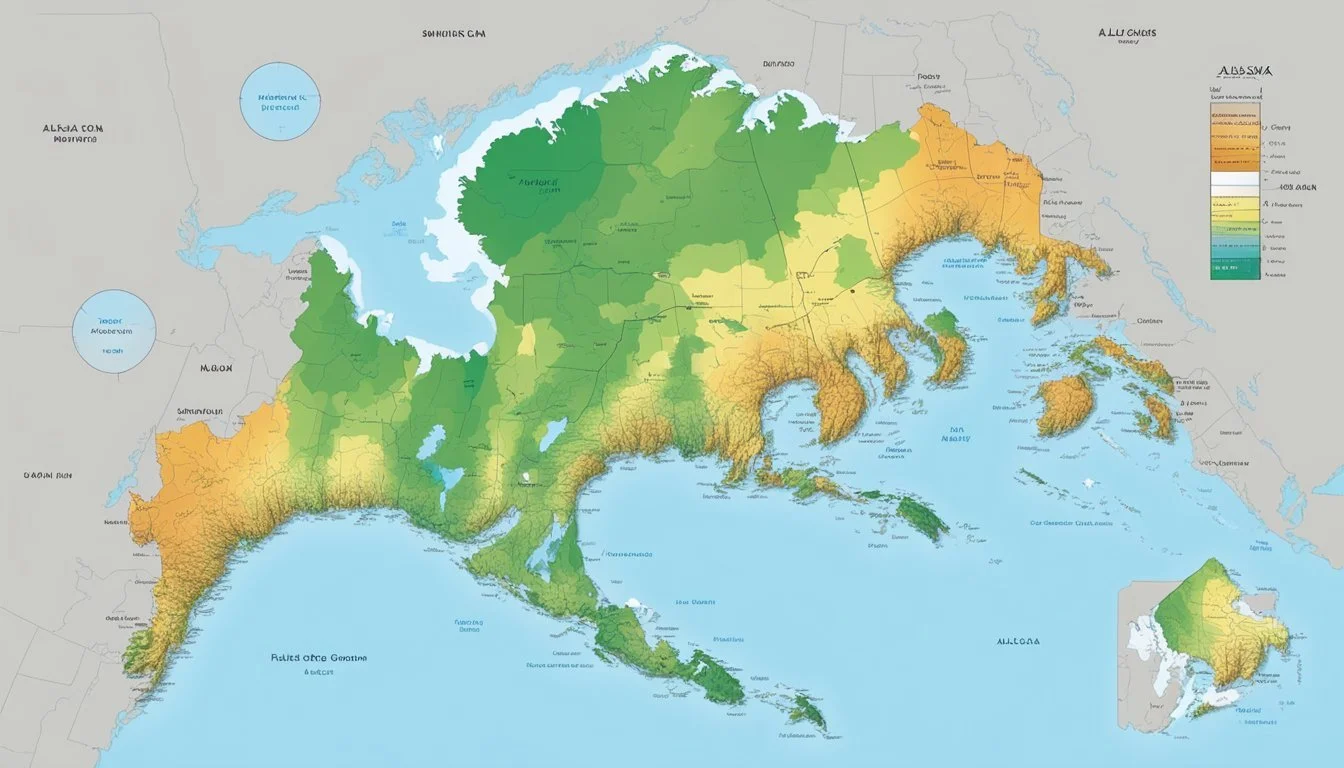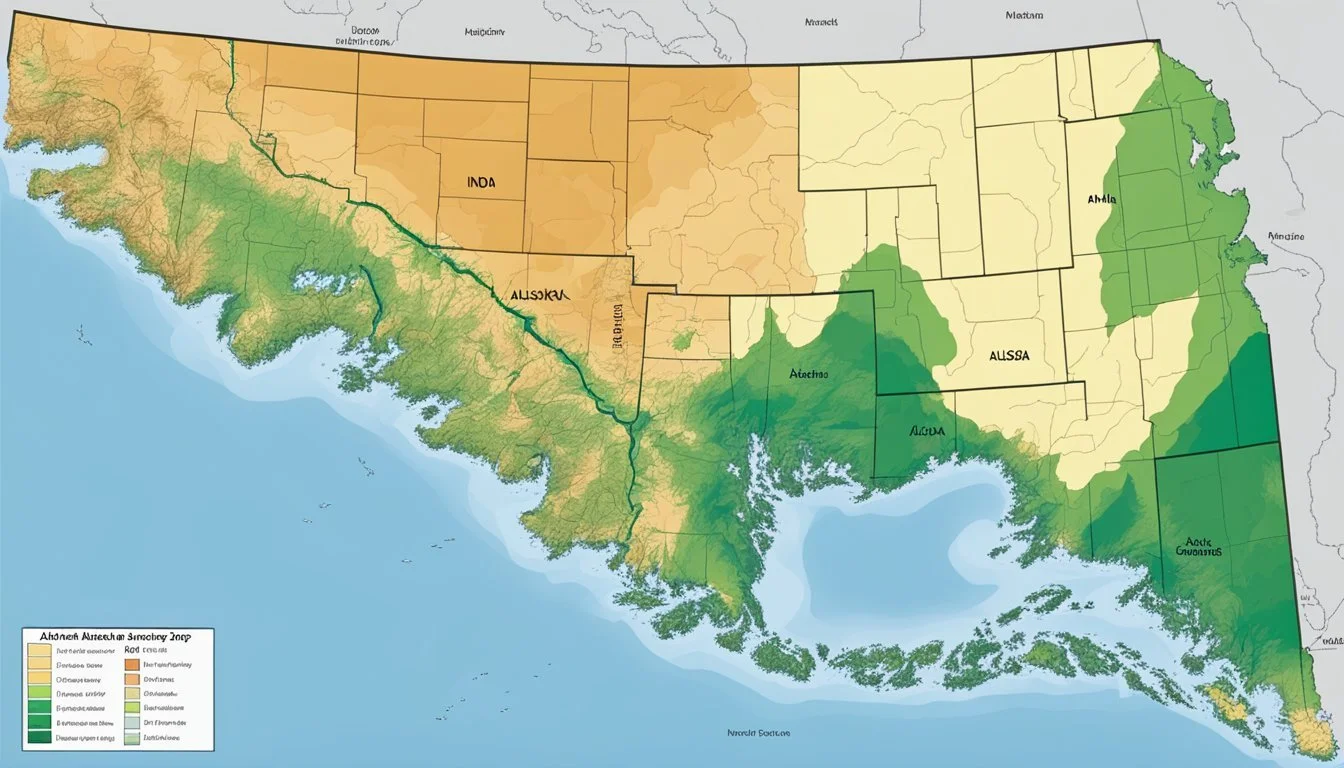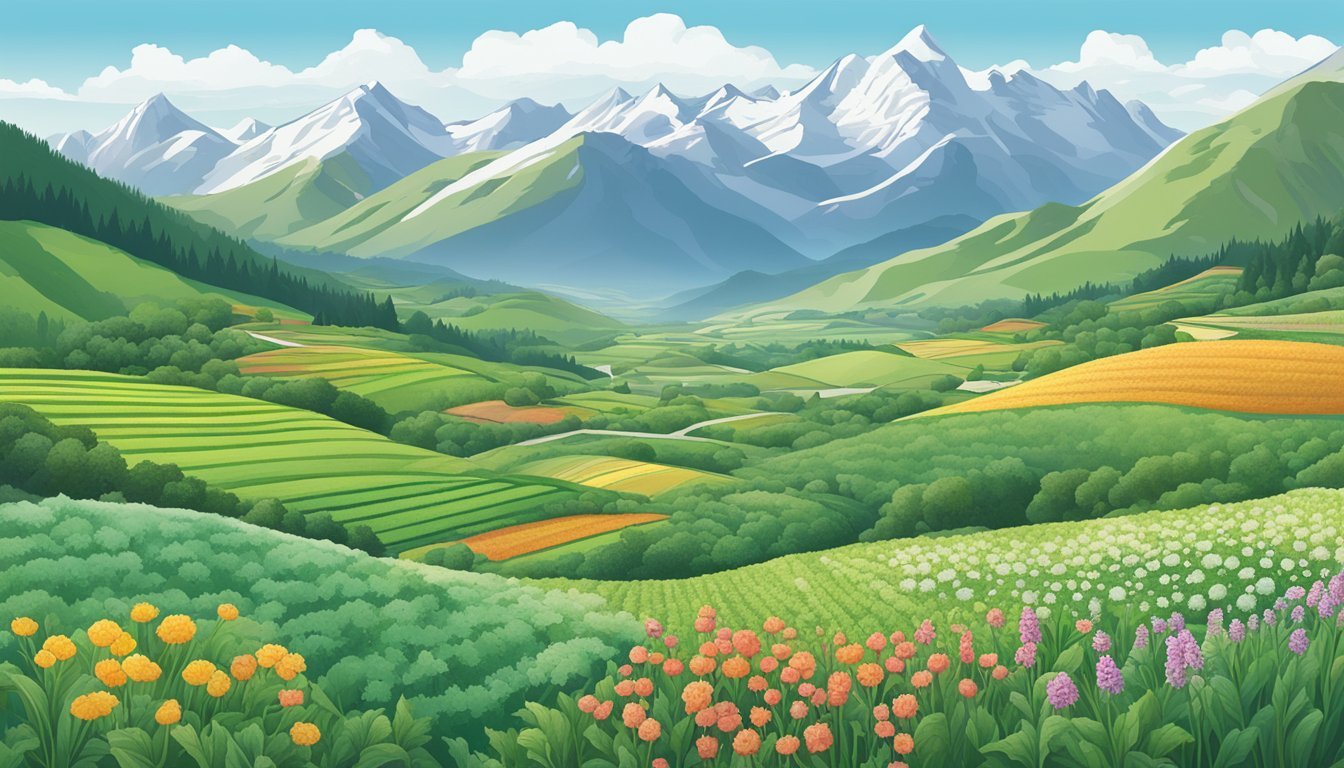USDA Hardiness Zones in Alaska
A Guide to Successful Gardening
Understanding the USDA Plant Hardiness Zone Map is critical for gardeners and agricultural professionals in Alaska. The map serves as a guideline for determining which plants are most suitable for a given location by indicating the average annual extreme minimum winter temperature. In recent updates, the zones within the map have been adjusted to reflect the warmer global temperatures, highlighting the need for updated planting strategies.
The state of Alaska encompasses a wide range of climatic conditions, which is why the Alaska Interactive USDA Plant Hardiness Zone Map provides invaluable localized information for Alaska's diverse landscape. These zones range broadly from 1b, with extreme lows of -55°F, to more temperate areas fitting into zone 4a, which sees minimum temperatures of -30°F to -25°F. This variance plays a pivotal role in determining the viability of perennial plants across the state.
To adapt to these challenges, the USDA unveils an updated Plant Hardiness Zone Map, which incorporates recent climate data to offer the most current recommendations for planting. Gardeners in Alaska can benefit from this resource by selecting plants that have the best chance for success in their specific zones, ensuring healthier gardens and more robust agricultural production.
Understanding USDA Hardiness Zones
The USDA Hardiness Zone system is a classification that guides gardeners and growers in determining which plants are most likely to thrive in specific locations. These zones are delineated by the average annual extreme minimum winter temperature, divided into 10-degree Fahrenheit increments.
Each zone on the plant hardiness zone map is further split into 'a' and 'b' segments representing 5-degree Fahrenheit differences. The zones range numerically from 1a, encompassing the coldest temperatures, to 13b for the warmest areas.
Alaska, due to its vast and varied landscapes, features a range of USDA zones. Its wide temperature gradients are reflected in the zones:
Zone 1b: -55°F to -50°F
Zone 2a: -50°F to -45°F
Zone 2b: -45°F to -40°F
Zone 3a: -40°F to -35°F
...and so forth, with each consecutive zone representing a slightly milder climatic region.
The USDA Plant Hardiness Zone Map is a crucial tool for anyone invested in horticulture, as it helps in selecting plants suited to the climatic challenges of their specific area. By referring to this map, individuals can assess the compatibility of perennial plants with their local environmental conditions.
It's essential to note that while the hardiness zone is a fundamental aspect to consider, successful planting also depends on other factors such as soil quality, moisture availability, and exposure to sun and wind.
The USDA Hardiness Zone Map for Alaska
The United States Department of Agriculture (USDA) Hardiness Zone Map is an essential guide for gardeners and growers in Alaska to ascertain the most suitable plants for their locale, based on the average annual minimum winter temperature.
Overview of Alaska Climate Zones
Alaska's climate zones are numerous and varied, reflecting the state's vast geographic expanse and diverse environments. The USDA Hardiness Zone Map utilizes a Geographic Information System (GIS) to visually represent these zones. This system divides the regions into zones by 10-degree Fahrenheit increments, with detailed subdivisions at 5-degree intervals to provide greater precision for critical gardening and farming decisions. The state's zones span from the frigid Zone 1b, where temperatures can plummet to below -50°F, to the more temperate Zone 7a, which experiences minimum temperatures between 0°F to 5°F.
Detailed USDA Alaska Planting Zones Map
A more detailed view of the USDA Alaska Planting Zones Map delineates the state into specific areas where certain plants can survive and thrive, depending on local climatic conditions. For instance:
Zone 4b: Locations such as Nome experience average annual extreme minimum temperatures ranging from -25°F to -20°F.
Zone 4a: Regions like Palmer and Wasilla fall into this zone, where the temperatures range from -30°F to -25°F.
Zone 2a: Areas such as Tok fall into colder zones, with minimum temperatures hovering between -50°F and -45°F.
These planting zones provide an invaluable reference for understanding the Alaska climate zones and aid in the selection of plant species that are best adapted to the state's wide-ranging conditions.
How to Use the USDA Plant Hardiness Zone Map
The USDA Plant Hardiness Zone Map is a critical tool for gardeners in Alaska, offering insights into which plants can survive the harsh winter temperatures. It functions through a classification system indicating the average annual extreme minimum temperatures of different regions.
Navigating the Interactive GIS-Based Map
The Interactive GIS-based map allows users to zoom in on their specific location to ascertain their hardiness zone. After accessing the website, one can utilize the search box to input their zip code, enabling a narrowed-down view of the map corresponding to the entered location. The data is frequently updated to reflect any climatic changes, and it's crucial for users to check for the latest version when planning their gardens.
Understanding Map Downloads and Updates
Users can download the map from the same USDA website for detailed analysis and offline usage. There are options available to download various formats suited for print or academic purposes. Enthusiasts should ensure to check for the most recent updates to the map, as these will provide the most accurate and relevant information on plant hardiness zones, which is especially important in a state with climatic extremes like Alaska. The website's updates section contains the latest revisions, reflecting changes in climate patterns and data accuracy.
Planting and Gardening in Alaska's Hardiness Zones
Alaska's diverse hardiness zones dramatically influence what gardeners and growers can cultivate. Understanding the specific zones, such as zone 1, which signifies some of the coldest areas, is crucial for successful gardening in the state.
Selecting Plants for Your Zone
Gardeners should select plants based on their hardiness zone to ensure they can withstand local winter temperatures. Alaska spans a variety of zones, from the frigid zone 1 to the more temperate zone 8b.
Trees: Hardy trees like the Sitka Spruce thrive in colder zones, while fruit trees may only be suitable in Alaska's warmer areas.
Vegetables: Cold-hardy vegetables like kale and Brussels sprouts are suitable for Alaska's colder zones. Gardeners should consult the 2023 USDA Plant Hardiness Zone Map for zone-specific guidance.
Flowers: Perennials that can endure freezing temperatures, such as the Alaska State Flower, the forget-me-not, are recommended for colder zones like zone 1.
Gardening Tips for Cold Weather
Gardeners in Alaska must employ strategies to extend their growing season and protect their plants from cold weather.
Microclimates: Create microclimates using structures like cold frames or greenhouses to shelter vegetables and flowers from the harsh conditions.
Soil Preparation: Incorporate organic matter to improve soil warmth and fertility. This aids root development, especially during the short Alaskan growing season.
Timing: Gardeners should carefully plan their planting schedules, as some zones have a very limited frost-free period. Consulting resources like Gardening Know How can inform gardeners about the optimal timing for their zone.
It's important for Alaska's gardeners and growers to understand their local hardiness zone and choose their plants accordingly, using the resources available to optimize their garden's potential in the face of cold climate challenges.
Hardiness Zones and Cold Weather Adaptation
Understanding the hardiness zones in Alaska is crucial for the survival of plants in the region, specifically perennial plants, as they must withstand extreme minimum winter temperatures.
Survival of Plants in Extreme Temperatures
Perennial plants in Alaska face the challenge of surviving within a range of hardiness zones, from the coldest zones like 1b with temperatures dipping to -55°F, to the relatively milder zone 7a. The USDA Hardiness Zone Map illustrates these 10-degree F zones, guiding gardeners on the extreme minimum temperature that plants must endure to survive the winter months.
Half Zone and Microclimate Considerations
The USDA map further breaks down these zones into 5-degree F half zones to provide a more accurate reflection of the local climates, which is particularly relevant in a diverse and expansive state like Alaska. This granularity helps in understanding microclimates, small areas where the climate differs from the surrounding area, to ensure the survival and adaptation of plants in the harsh Alaskan environment.
Agricultural Research and Resources
The USDA's Agricultural Research Service, in collaboration with Oregon State University, develops resources such as the Hardiness Zone Map to aid the agricultural community. This map is an essential tool for gardeners and farmers across the United States, including Alaska, Puerto Rico, and various regional zones.
USDA Agricultural Research Service
The United States Department of Agriculture (USDA) Agricultural Research Service (ARS) plays a pivotal role in conducting agricultural research at a national level. The ARS facilitates the creation of the USDA Plant Hardiness Zone Map, which categorizes regions based on their average annual extreme minimum winter temperature into 10-degree Fahrenheit zones.
Partnership with Oregon State University
In a collaborative effort with the USDA ARS, Oregon State University's (OSU) PRISM Climate Group co-developed the updated Plant Hardiness Zone Map. This partnership produced a map with enhanced accuracy and detailed zoning, specifically beneficial to the diverse climates within Alaska and regions throughout the United States and Puerto Rico. The zones help determine the most viable perennial plants and are pivotal for agricultural planning.
Understanding Local Variations in Hardiness Zones
The resilience of plants in Alaska's diverse landscapes greatly depends on understanding the specific hardiness zone of each location, which are influenced by local wind patterns and urban environments.
Effects of Wind and Geography
Local wind conditions can significantly alter the microclimate of an area, impacting the hardiness zones in Alaska. For example, areas like Nome fall within USDA Zone 4b where brisk Bering Sea winds can lower the temperature, affecting plant survival. Furthermore, geographic features such as mountains can create rain shadows or windbreaks that contribute to the existent variation between regions.
Key Geographic Influences on Plant Hardiness:
Mountains: Act as barriers to cold winds and influence precipitation patterns.
Bodies of Water: Moderate temperatures, leading to warmer winter conditions nearby.
Open Land: More susceptible to temperature fluctuations and harsher winds.
Influence of Urban Heat Islands
Urban areas, with their high concentration of concrete and blacktop, often form heat islands. In cities like Anchorage, the typical USDA Zone designation might not accurately represent the local growing conditions, as the urban environment can be significantly warmer than surrounding rural areas. The use of a geographic information system (GIS) helps to pinpoint these variations within the cityscape, further refining the hardiness zones on a town-by-town basis.
Contributors to Urban Heat Islands:
Concrete and Asphalt: Absorb and re-radiate heat, raising temperatures.
Buildings and Roads: Alter wind patterns, generally reducing wind speeds.
Waste Heat: From vehicles and industry, further increases local temperatures.
The Impact of Climate Change on USDA Hardiness Zones
USDA Hardiness Zones provide critical guidance for gardeners and researchers, indicating which plants are most likely to thrive at a location. However, climate change has altered these zones, necessitating updates to maps that reflect these shifts.
Historical Changes in Zones
Historically, USDA Hardiness Zones in Alaska have provided a framework reflecting the area's climate conditions, particularly minimum winter temperatures. Reviewing historical weather data reveals that as temperatures rise, hardiness zones shift northward, suggesting a significant alteration of the planting landscape. The zones have evolved as milder winters have allowed for a broader range of plant species to potentially thrive further north.
Predictions for Future Zone Shifts
Predictions for future zone shifts due to climate change indicate that Alaska, alongside other regions, will continue to experience changes in plant hardiness zones. The USDA Plant Hardiness Zone Map is expected to demonstrate a further northward shift for suitable zones for various plant species. While specific prediction models vary, the common consensus is that zone boundaries will migrate in response to increasing average temperatures and altered precipitation patterns. This shift will affect not only gardeners but also agricultural strategies and native plant ecosystems.
Practical Applications and Tools
Understanding USDA Hardiness Zones is critical for anyone involved in horticulture or gardening in Alaska. These zones provide valuable insights on what plants can grow in specific areas, considering average annual minimum temperature ranges.
Horticultural Applications
The USDA Hardiness Zones are essential for gardeners, landscapers, and botanists to determine which plant species can survive the Alaskan climate. Each zone reflects particular environmental conditions, assisting horticulturists in selecting plants that are most likely to thrive. For instance, an area classified within Zone 3a has different planting opportunities than Zone 7b, where the climate is milder. A gardener looking to plant a botanical garden in Anchorage would find it practical to refer to these zones, as they significantly affect the survivability of various plants, from native Alaskan species to non-native ornamentals.
Using the Search Function on USDA's Website
The USDA Plant Hardiness Zone Map (PHZM) website offers a search function that can be used to find the hardiness zone for a specific area. Gardeners must enter a ZIP code into the search box, and the website will display the zone information. This tool is supported by a high resolution mapping interface that reflects the Prism Climate Group's data, enabling detailed and accurate zone delineations necessary for botanical planning. To ensure functionality, a reliable broadband internet connection is recommended, paving the way for swift and effortless search capabilities.
Additional Information and Support
For those seeking to deepen their understanding of the USDA Plant Hardiness Zone map in Alaska, various resources are readily available. This includes options for physical maps and valuable insights provided by government entities and educational institutions.
Accessing Print Copies of the Map
Print copies of the USDA Plant Hardiness Zone Map can be obtained for those who prefer a tangible reference. Gardeners and educators may find it practical to have a physical map on hand for planning and teaching purposes. These maps are available through certain agricultural extension offices and may sometimes be found in local gardening stores.
Government and Educational Resources
Government organizations and educational institutions play a pivotal role in distributing knowledge about the Alaska USDA zones. For high-resolution digital versions of the map, the official USDA Plant Hardiness Zone Map website provides downloadable files suitable for printing. Furthermore, extension services at local universities often offer workshops, fact sheets, and personalized advice to assist with region-specific gardening challenges.
Frequently Asked Questions
Understanding the USDA hardiness zones is crucial for gardeners in Alaska, as it guides which plants are best suited for their specific location based on the average annual minimum winter temperature.
Which USDA hardiness zone does Anchorage, Alaska fall under?
Anchorage, Alaska, is primarily in USDA hardiness zone 5b, which means the average minimum temperature ranges from -15 to -10 degrees Fahrenheit.
How can I find the most recent USDA hardiness zones map for Alaska?
The most recent USDA hardiness zones map for Alaska can be accessed through the USDA Plant Hardiness Zone Map website.
What are the specific growing zones within the state of Alaska?
Alaska's growing zones range from 1b, one of the coldest, to a milder zone 7b. More detailed information can be found on the Plantmaps dedicated to Alaska's zone diversity.
What is the designated USDA planting zone for Fairbanks, Alaska?
Fairbanks, Alaska, falls into USDA planting zone 2b, with extreme minimum temperatures of -45 to -40 degrees Fahrenheit.
Can you provide an overview of Alaska's climate zones for gardening?
Alaska's climate zones for gardening extend from the frigid Zone 1b areas to relatively warmer Zone 7b locations, reflecting a great variety in suitability for different plant species.
What planting zone is assigned to Soldotna, Alaska by the USDA?
The USDA assigns Soldotna, Alaska to planting zone 4b, with average minimum temperatures ranging from -25 to -20 degrees Fahrenheit.










